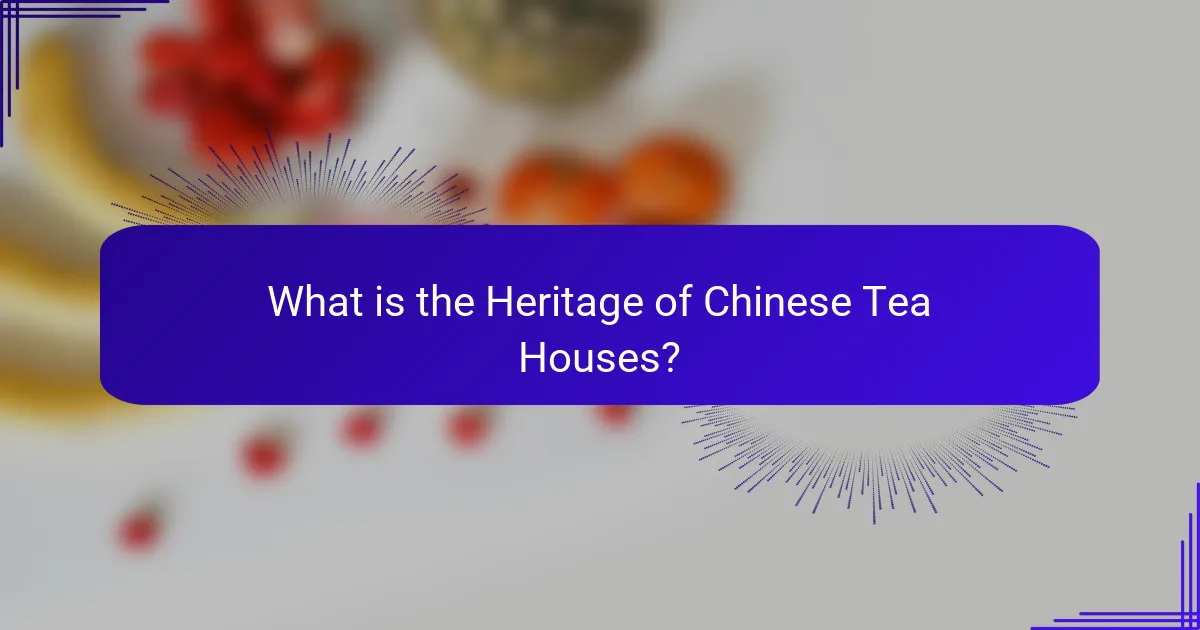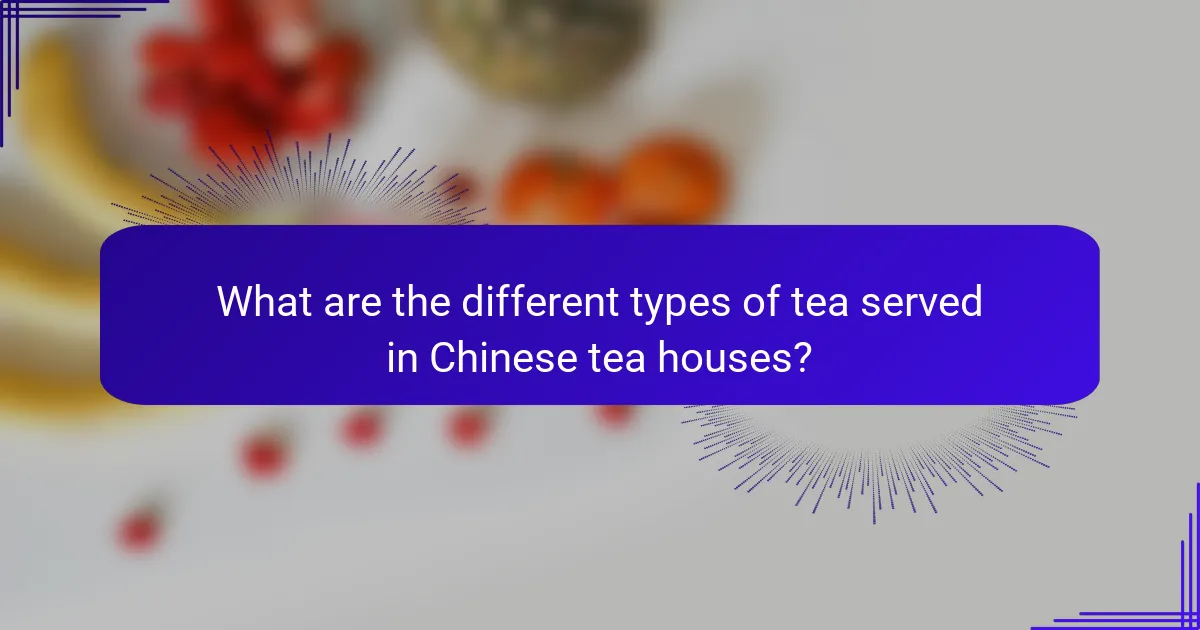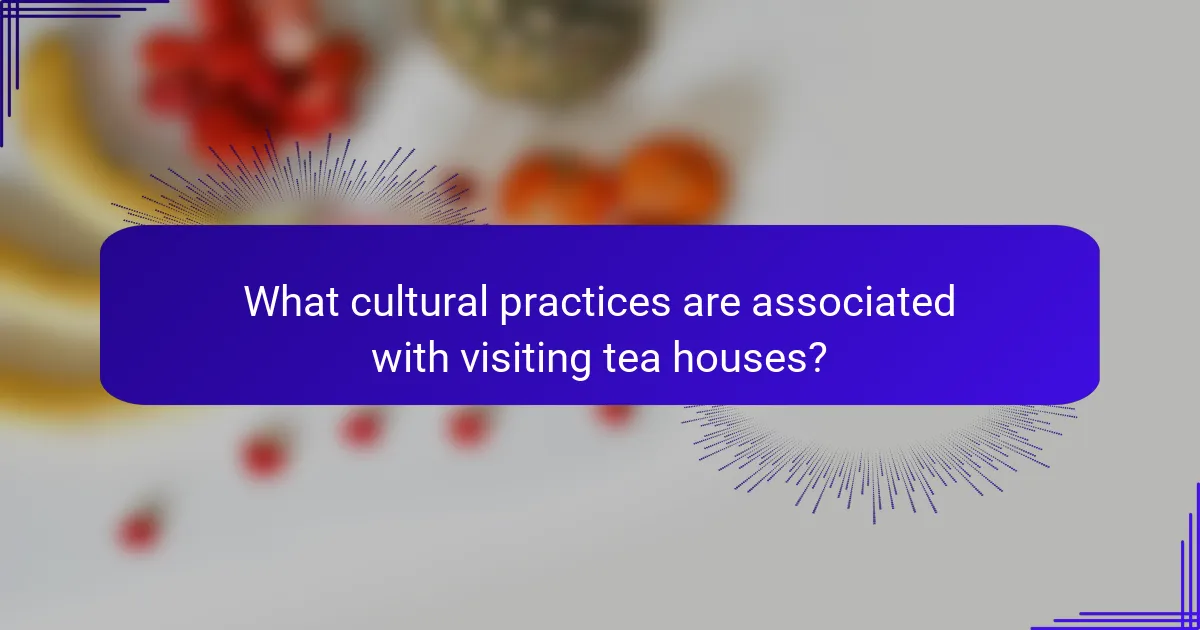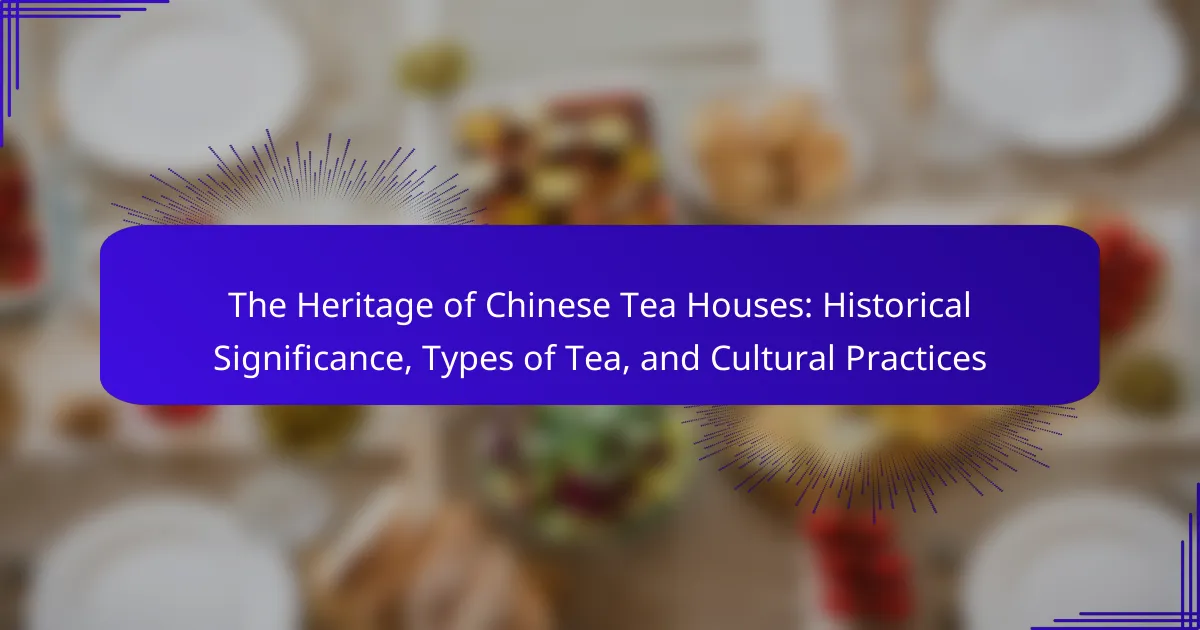
What is the Heritage of Chinese Tea Houses?
The heritage of Chinese tea houses is a rich cultural tradition that dates back to the Tang Dynasty (618–907 AD). These establishments served as social hubs where people gathered to enjoy tea and engage in conversation. The practice of drinking tea became widespread during the Song Dynasty (960–1279 AD), further popularizing tea houses. They played a significant role in the development of tea culture in China, influencing social customs and artistic expressions. Tea houses often feature traditional architecture and decor, reflecting regional styles and aesthetics. The variety of teas served in these establishments showcases China’s diverse tea culture. Today, tea houses continue to thrive, preserving historical practices while adapting to modern tastes and preferences.
How did Chinese tea houses originate and evolve over time?
Chinese tea houses originated during the Tang Dynasty (618-907 AD) as places for socializing and enjoying tea. Initially, they served as simple stalls where tea was sold. The popularity of tea spread, leading to the establishment of more formal tea houses. By the Song Dynasty (960-1279 AD), tea houses became cultural hubs for poetry, music, and conversation. They evolved into elegant venues, often featuring intricate decor and specialized tea services. The Ming Dynasty (1368-1644 AD) saw further refinement, with tea houses becoming integral to urban life. Today, they continue to be important cultural spaces, reflecting the rich history and traditions of tea in China.
What historical events influenced the development of tea houses?
The development of tea houses was influenced by several historical events. The Tang Dynasty (618-907 AD) saw the rise of tea consumption in China. This period established tea as a popular beverage among the elite. The Song Dynasty (960-1279 AD) further popularized tea culture, leading to the establishment of tea houses. During this time, tea drinking became a social activity. The Ming Dynasty (1368-1644 AD) introduced loose leaf tea, enhancing the tea house experience. The Qing Dynasty (1644-1912 AD) saw tea houses become centers for cultural exchange and intellectual discussion. The Opium Wars in the 19th century expanded global interest in Chinese tea. These events collectively shaped the evolution of tea houses into significant cultural institutions in China.
How have architectural styles of tea houses changed throughout history?
Architectural styles of tea houses have evolved significantly over time. Early tea houses in China featured simple, utilitarian designs. These structures often included wooden beams and thatched roofs. During the Tang Dynasty, tea houses became more elaborate, incorporating intricate carvings and decorative elements. The Song Dynasty further advanced this trend, emphasizing harmony with nature in their designs. By the Ming and Qing Dynasties, tea houses showcased elegant structures with courtyards and gardens. Modern tea houses blend traditional elements with contemporary architecture. This evolution reflects changes in cultural practices and social interactions surrounding tea consumption. Historical records indicate these shifts align with broader architectural movements in China.
What role do tea houses play in Chinese culture?
Tea houses serve as vital social and cultural hubs in Chinese culture. They are places for relaxation, conversation, and community bonding. Tea houses have a long history, dating back to the Tang Dynasty (618-907 AD). They facilitate traditional tea drinking rituals, showcasing various tea types and brewing methods. Patrons often engage in games, music, and performances while enjoying tea. These establishments also play a role in preserving cultural traditions and fostering interpersonal relationships. The ambiance of tea houses encourages deep conversations and connections among visitors. Overall, tea houses are integral to the social fabric of Chinese society.
How do tea houses serve as social and community hubs?
Tea houses serve as social and community hubs by providing a space for people to gather and interact. They facilitate social connections among individuals from diverse backgrounds. Tea houses often host cultural events, enhancing community engagement. They offer a relaxed atmosphere that encourages conversation and bonding. Many tea houses feature communal seating, promoting interaction among patrons. They serve traditional teas, which can spark discussions about culture and heritage. Additionally, tea houses may provide entertainment, such as live music or poetry readings, fostering a sense of community. Historically, tea houses have been integral to social life in many cultures, reinforcing their role as community centers.
What significance do tea houses hold in traditional Chinese ceremonies?
Tea houses are significant in traditional Chinese ceremonies as they serve as venues for cultural gatherings and rituals. They facilitate social interaction and foster community bonds. In these settings, tea is often prepared and served with specific rituals, emphasizing respect and hospitality. The act of tea drinking is deeply embedded in Chinese culture, symbolizing peace and harmony. Tea houses also provide a space for artistic expression, including poetry and music, enhancing the cultural experience. Historically, they have been central to important life events such as weddings and festivals. This role in ceremonies underscores the tea house’s importance in preserving and promoting Chinese heritage.

What are the different types of tea served in Chinese tea houses?
Chinese tea houses serve various types of tea, including green tea, black tea, oolong tea, white tea, and pu-erh tea. Green tea is known for its fresh flavor and is often consumed for its health benefits. Black tea, which is fully oxidized, has a robust taste and is popular in both China and globally. Oolong tea is partially oxidized, offering a unique flavor profile that varies between green and black tea. White tea is minimally processed, providing a delicate and subtle taste. Pu-erh tea is fermented and aged, known for its earthy flavor and digestive benefits. Each type of tea reflects the rich tradition and cultural significance of tea in Chinese society.
What are the most popular types of tea in Chinese tea culture?
The most popular types of tea in Chinese tea culture include green tea, black tea, oolong tea, white tea, and pu-erh tea. Green tea is known for its fresh flavor and high antioxidant content. Black tea, often referred to as red tea in China, is fully oxidized and has a robust taste. Oolong tea is partially oxidized, offering a unique flavor profile that varies widely. White tea is the least processed, known for its delicate taste and subtle aroma. Pu-erh tea is fermented and aged, providing a rich, earthy flavor. These teas are integral to Chinese culture and are enjoyed in various ceremonies and daily practices.
How is green tea prepared and served in tea houses?
Green tea is prepared by steeping the leaves in hot water. The water temperature typically ranges from 160°F to 185°F. Tea houses often use high-quality loose leaves for optimal flavor. The steeping time usually lasts between 1 to 3 minutes, depending on the type of green tea.
Once steeped, the tea is poured into small cups. These cups are often made of porcelain or glass to showcase the tea’s color. Some tea houses serve green tea with traditional snacks or pastries. The serving style emphasizes the tea’s aroma and taste, enhancing the overall experience.
This preparation method reflects centuries of cultural practices in Chinese tea houses. The careful attention to temperature and timing showcases the importance of quality in tea service.
What distinguishes oolong tea from other varieties in tea houses?
Oolong tea is distinguished from other varieties by its unique semi-oxidation process. This process results in a flavor profile that is between green and black tea. Oolong tea often exhibits floral and fruity notes, which are less pronounced in other tea types. The leaves are typically rolled into tight balls or long twists, enhancing the aroma during brewing. Its preparation often involves multiple infusions, allowing for a complex tasting experience. Oolong tea also has a higher caffeine content than green tea but lower than black tea. This balance makes it a versatile choice for tea drinkers. The variety of oolong, such as Tie Guan Yin and Da Hong Pao, showcases distinct regional characteristics. These factors collectively set oolong tea apart in tea houses.
What unique attributes do different teas possess?
Green tea contains high levels of antioxidants, particularly catechins. These compounds contribute to various health benefits, including improved metabolism. Black tea is known for its robust flavor and higher caffeine content compared to other teas. It undergoes full oxidation, which enhances its rich taste profile. Oolong tea is partially oxidized, offering a unique balance between green and black tea characteristics. It often features floral and fruity notes. White tea is the least processed, retaining a delicate flavor and high antioxidant levels. Herbal teas, while not traditional teas, possess various unique attributes based on their plant ingredients, such as chamomile’s calming properties. Each tea type’s unique attributes significantly influence its flavor, health benefits, and cultural significance.
How does the region of origin affect the flavor profile of Chinese teas?
The region of origin significantly influences the flavor profile of Chinese teas. Different regions have unique climates, soils, and elevation levels. For example, teas from Yunnan are known for their rich, earthy flavors. In contrast, teas from Fujian often exhibit floral and fruity notes. The terroir, or environmental factors, plays a crucial role in shaping these flavors. Historical cultivation practices also contribute to the distinct tastes of teas from various areas. For instance, the traditional methods used in Hangzhou produce the renowned Longjing tea, which has a sweet, nutty flavor. Thus, the interplay of geography and cultivation methods creates diverse flavor profiles across Chinese teas.
What health benefits are associated with various types of Chinese tea?
Chinese tea offers various health benefits depending on its type. Green tea is known for its high antioxidant content, which can improve heart health and aid in weight loss. Black tea can enhance gut health and reduce the risk of stroke due to its flavonoid content. Oolong tea may boost metabolism and help with fat oxidation. White tea has anti-aging properties and can improve skin health due to its polyphenols. Herbal teas, like chrysanthemum tea, can aid in reducing inflammation and improving vision. Each type of Chinese tea provides unique health advantages, supported by studies showing their beneficial compounds.

What cultural practices are associated with visiting tea houses?
Cultural practices associated with visiting tea houses include traditional tea ceremonies, social gatherings, and culinary experiences. Tea ceremonies emphasize the art of tea preparation and presentation, reflecting respect and mindfulness. Social gatherings often involve friends or family coming together to share stories and enjoy tea. Culinary experiences may include pairing tea with local snacks or meals, enhancing the overall enjoyment. Additionally, many tea houses serve as venues for cultural performances, such as music or poetry readings. These practices foster community, preserve traditions, and promote appreciation for tea culture.
How do traditional tea ceremonies differ from casual tea drinking?
Traditional tea ceremonies are structured rituals focused on the preparation and presentation of tea. These ceremonies emphasize mindfulness, aesthetics, and cultural significance. In contrast, casual tea drinking is informal and often lacks specific rituals or deep cultural meaning.
Tea ceremonies typically involve precise steps and utensils, highlighting the artistry of tea making. They often include specific types of tea, such as high-quality green or oolong teas. Casual tea drinking usually utilizes readily available tea bags or loose leaves without special preparation.
The atmosphere in tea ceremonies is serene, encouraging reflection and appreciation. In casual settings, tea is often consumed quickly and without ceremony. This distinction highlights the cultural depth of traditional tea practices compared to the simplicity of casual consumption.
What rituals are commonly observed during tea ceremonies in tea houses?
Common rituals observed during tea ceremonies in tea houses include the meticulous preparation of tea, serving the tea in a specific order, and using traditional utensils. The tea master often performs a series of precise movements while brewing the tea. This includes warming the teapot and cups before brewing. The tea leaves are measured accurately, and hot water is poured carefully to achieve the right temperature.
Participants often express gratitude before tasting the tea. After serving, the tea is poured into small cups, allowing for appreciation of aroma and flavor. The process emphasizes mindfulness and respect for the tea. Rituals may also involve sharing stories or discussing the significance of the tea being served. These practices reflect cultural values and enhance the experience of enjoying tea.
How does the etiquette of tea drinking vary across different regions of China?
The etiquette of tea drinking varies significantly across different regions of China. In Guangdong, tea drinking is often accompanied by dim sum, emphasizing a social dining experience. The practice involves serving tea to guests first as a sign of respect. In contrast, in the northern regions like Beijing, tea is usually consumed in a more straightforward manner, often without accompanying food.
In the Jiangsu and Zhejiang provinces, the Gongfu tea ceremony is popular, showcasing elaborate preparation and presentation. This method emphasizes the quality of the tea and the skill of the server. Meanwhile, in Tibet, butter tea is a staple, reflecting local customs and dietary needs, which is quite different from the traditional green or black teas found in other areas.
Additionally, in the Fujian province, oolong tea is often brewed multiple times, with each infusion being a part of the experience. Each region’s unique customs highlight the diversity of tea culture in China, influenced by local history and social practices.
What modern influences are shaping the future of Chinese tea houses?
Modern influences shaping the future of Chinese tea houses include globalization, technology, and changing consumer preferences. Globalization introduces diverse tea cultures and practices, enriching traditional tea house experiences. Technology impacts tea preparation and customer engagement through online ordering and digital marketing. Changing consumer preferences favor health-oriented and sustainable products, prompting tea houses to adapt their offerings. Additionally, younger generations are seeking modern aesthetics and social experiences in tea houses. These influences collectively drive innovation and evolution within the traditional tea house framework.
How are contemporary tea houses adapting to global trends?
Contemporary tea houses are adapting to global trends by incorporating diverse tea offerings and modern ambiance. They now feature international tea varieties alongside traditional Chinese teas. Many tea houses are also embracing sustainability by sourcing organic and ethically produced teas. Additionally, they are enhancing customer experience through innovative brewing methods and interactive tea tastings. The use of technology, such as mobile ordering and social media marketing, has become prevalent. These adaptations are driven by a growing consumer interest in health and wellness, as well as a desire for unique experiences. Statistics show that the global tea market is projected to reach $73 billion by 2024, indicating a rising demand for diverse tea experiences.
What innovations are being introduced to enhance the tea drinking experience?
Innovations enhancing the tea drinking experience include smart brewing devices and personalized tea blends. Smart brewing devices allow precise temperature and steeping time control. These devices often connect to mobile apps for user convenience. Personalized tea blends cater to individual taste preferences and health benefits. Companies now offer customizable tea subscriptions based on user profiles. Additionally, eco-friendly packaging is being adopted to reduce waste. Some brands are incorporating augmented reality for interactive tea education. These innovations aim to improve enjoyment and sustainability in tea consumption.
What tips can enhance your visit to a Chinese tea house?
To enhance your visit to a Chinese tea house, consider learning about the different types of tea offered. Understanding the tea varieties can improve your tasting experience. Engage with the staff to gain insights into the brewing process. This interaction can deepen your appreciation for the tea culture. Arrive with an open mind to explore new flavors and aromas. Many tea houses offer tea ceremonies, which provide a unique cultural experience. Be respectful of the customs and etiquette observed in the tea house. This respect is essential in traditional settings. Lastly, take your time to enjoy the ambiance and tranquility. A relaxed mindset can enhance your overall experience.
The primary entity of this article is Chinese tea houses, which hold significant historical and cultural importance in China. The article explores the heritage of these establishments, tracing their origins from the Tang Dynasty to their evolution through various dynasties, highlighting their role as social and cultural hubs. It discusses the types of tea served, including green, black, oolong, white, and pu-erh, along with their unique attributes and health benefits. Additionally, the article examines the architectural styles of tea houses, traditional tea ceremonies, and modern influences shaping their future, providing a comprehensive overview of the rich traditions and practices associated with Chinese tea culture.
